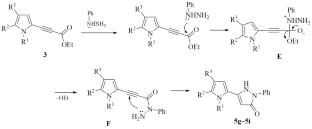酰基乙基吡咯和吡咯丙酸酯与肼的相互作用:吡咯乙基酰肼和吡咯-吡唑系综的合成
IF 0.9
4区 化学
Q4 CHEMISTRY, ORGANIC
引用次数: 0
摘要
2-酰基乙基吡咯与肼(水合肼和苯肼,EtOH, 40℃,0.5 h)环化生成吡咯基吡唑,产率为63-95%。与酰基乙基吡咯不同,吡咯酰丙酸酯与水合肼和苯肼的反应方式不同:与水合肼在低温(EtOH, 0℃,1 h)下相互作用可选择性生成吡咯酰乙基肼(收率90-97%),而在回流(EtOH, 1 h)下与肼和苯肼反应可生成吡咯酰吡唑酮或吡咯酰吡唑酮(收率88-97%)。本文章由计算机程序翻译,如有差异,请以英文原文为准。

Interaction of Acylethynyl Pyrroles and Pyrrolyl Propynoates with Hydrazines: Synthesis of Pyrrolylethynyl Hydrazides and Pyrrol–Pyrazole Ensembles
2-Acylethynylpyrroles cyclize with hydrazines (hydrazine hydrate and phenylhydrazine, EtOH, 40°C, 0.5 h) to form pyrrolylpyrazoles in 63–95% yield. Unlike acylethynylpyrroles, pyrrolylpropynoates react with hydrazine hydrate and phenylhydrazine differently: interaction with hydrazine hydrate at a low temperature (EtOH, 0°C, 1 h) leads to the selective formation of pyrrolylethynylhydrazides (yield, 90–97%), whereas under reflux (EtOH, 1 h) in reactions with hydrazine and phenylhydrazine pyrrolylpyrazolones or pyrrolylpyrazolones are formed (yield, 88–97%).
求助全文
通过发布文献求助,成功后即可免费获取论文全文。
去求助
来源期刊
CiteScore
1.40
自引率
25.00%
发文量
139
审稿时长
3-6 weeks
期刊介绍:
Russian Journal of Organic Chemistry is an international peer reviewed journal that covers all aspects of modern organic chemistry including organic synthesis, theoretical organic chemistry, structure and mechanism, and the application of organometallic compounds in organic synthesis.

 求助内容:
求助内容: 应助结果提醒方式:
应助结果提醒方式:


